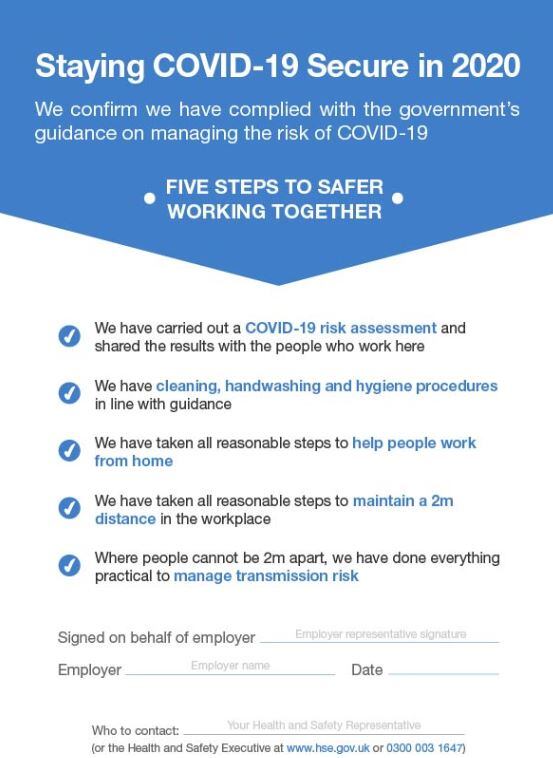The guidance, released after the Prime Minister Boris Johnson’s announcement that pubs would be allowed to reopen in July, gives various levels of detail on how pubs and bars should look to reopen safely.
In the 43-page document, operators are urged to think about risk including security, control measures and advises which bodies to consult with during and after the process.
Here is a brief guide to the Thinking About Risk section of the Government’s Keeping workers and customers safe during Covid-19 in restaurants, pubs, bars and takeaways report.
Risk assessment
Pubs must carry out risk assessments for each of their venues and any offices they have, and use the information gathered to stop health and safety risks.
When doing this:
- Consider any security implications of any decisions made resulting from the risk assessment and any control measures put in place. Additional measures could present new or altered risks
- A risk assessment should help identify sensible measures to control risks in the workplace
- Pubs with fewer than five workers (or self-employed operators) don’t need to write down their risk assessment
- The risk assessment should help operators decide if everything has been done to prevent a health and safety risk
- A risk assessment guide can be found here
- Staff must be consulted on health and safety, which can be done by asking them about perceived risks
- A health and safety representative should be appointed if one isn’t already in place. This could be an elected member of staff. An employer cannot decide who the health and safety representative is
The guide said: “At its most effective, full involvement of your workers creates a culture where relationships between employers and workers are based on collaboration, trust and joint problem solving.
“As is normal practice, workers should be involved in assessing workplace risks and the development and review of workplace health and safety policies in partnership with the employer.
“Employers and workers should always come together to resolve issues. If concerns still cannot be resolved, see below for further steps you can take.”

The results of a risk assessment must be shared with the workforce and, if possible, published on your pub’s website. All employers with over 50 workers are expected to take both of these measures.
It is expected all businesses demonstrate to workers and customers that a proper risk assessment has been carried out, with the appropriate measures to mitigate risk put in place following the work.
Do this by displaying a notification of the activity in a prominent place in your site and/or on your website.
The Government advises using the notice to the right of this story.
Legal
Legally, it is the responsibility of an employer to keep their staff and customers safe, including any health and safety issues are prevented.
If an enforcing authority, such as the Health and Safety Executive (HSE) or a local authority identifies employers not taking action to comply with public health legislation and guidance on the control of public health risks, legal action could be taken.
Examples of non-compliance could include employers not taking action to ensure social distancing is in place where possible – two-metres for best practice or one-metre where two is not possible.
Not completing a risk assessment that takes into account coronavirus, or completing one and not putting in place measures to avoid identified issues, could be a breach of health and safety law.
If this is the case, enforcing authorities can provide advice and guidance to make a business complicit. However, serious breaches, negligence and a failure to comply with enforcement notices could constitute a criminal offense.
As such, operators could face serious fines and even imprisonment of up to two years.
Operators must also consider conditions set out in their licensing agreements.
The guide said: “Employers are expected to respond to any advice or notices issued by enforcing authorities rapidly and are required to do so within any timescales imposed by the enforcing authorities.
“The vast majority of employers are responsible and will join with the UK's fight against COVID-19 by working with the Government and their sector bodies to protect their workers and the public.
“However, regulators are carrying out compliance checks nationwide to ensure that employers are taking the necessary steps.”
Managing risk
“Employers have a duty to reduce workplace risk to the lowest reasonably practicable level by taking preventative measures,” said the guide.
“Employers must work with any other employers or contractors sharing the workplace so that everybody's health and safety is protected.
“In the context of Covid-19 this means protecting the health and safety of your workers and customers.”
Steps to be taken can and should include:
- Ensuring unwell staff and customers stay at home
- Handwashing and surface washing is increased in the venue
- Where working from home is not possible, every reasonable effort to comply with social distancing guidance should be met – two-metres ideally or one-metre with risk mitigations in place where two-metres is not viable
- When two-metre social distancing is not viable, mitigations should be considered and put in place to help prevent the risk of coronavirus transmission between staff and customers. Further preventatives can include:
- Further increasing of handwashing
- Limited activity time (rotate staff between indoor and outdoor activities)
- Using screens and barriers to separate workers, staff and customers from each other at points of service
- Using back-to-back or side-to-side working where possible rather than face-to-face
- Reduce the number of people each member of staff interacts with by using fixed teams or partnering
- If working face-to-face for a sustained period, an assessment of whether that activity is safe must be carried out, but no one is obliged to work in an ‘unsafe work environment’
- Facemasks and hand sanitising stations for staff and customers (could be an additional measure)
The guide added: “If you have not already done so, you should carry out an assessment of the risks posed by COVID-19 in your workplace as soon as possible.
“If you are currently operating, you are likely to have gone through a lot of this thinking already. We recommend that you use this document to identify any further improvements you should make.
“You must review the measures you have put in place to make sure they are working. You should also review them if they may no longer be effective or if there are changes in the workplace that could lead to new risks.”

